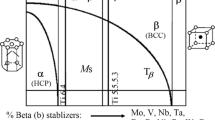Abstract
This work presents a study on the effect of low pressure cryogenic liquid nitrogen on cutting forces, friction coefficient, surface roughness of the machined surface and tool wear under high speed machining of a relatively new titanium alloy, Ti-5Al-4V-0.6Mo-0.4Fe. The experiments were conducted in dry and cryogenic conditions. The experimental results show that liquid nitrogen can reduce the friction force, friction coefficient and improve the surface roughness.







Similar content being viewed by others
References
Dhar NR, Islam S et al (2006) Wear behavior of uncoated carbide inserts under dry, wet and cryogenic cooling conditions in turning C-60 steel. J Braz Soc Mech Sci Eng 28:146–152
Dhar NR, Kamruzzaman M (2007) Cutting temperature, tool wear, surface roughness and dimensional deviation in turning AISI-4037 steel under cryogenic condition. Int J Mach Tools Manuf 47(5):754–759
Dhar NR, Paul S et al (2001) The influence of cryogenic cooling on tool wear, dimensional accuracy and surface finish in turning AISI 1040 and E4340C steels. Wear 249(10–11):932–942
Dhar NR, Paul S et al (2002) Machining of AISI 4140 steel under cryogenic cooling–tool wear, surface roughness and dimensional deviation. J Mater Process Technol 123(3):483–489
Dhar NR, Paul S et al (2002) Role of cryogenic cooling on cutting temperature in turning steel. J Manuf Sci Eng Trans ASME 124(1):146–154
Dong H, Bell T (2000) Enhanced wear resistance of titanium surfaces by a new thermal oxidation treatment. Wear 238(2):131–137
Ezugwu EO, Wang ZM (1997) Titanium alloys and their machinability-a review. J Mater Process Technol 68:262–274
Hong SY (2001) Economical and ecological cryogenic machining. J Manuf Sci Eng Trans ASME 123(2):331–338
Hong SY, Ding YC (2001) Cooling approaches and cutting temperatures in cryogenic machining of Ti-6Al-4V. Int J Mach Tools Manuf 41(10):1417–1437
Hong SY, Ding YH et al (2001) Friction and cutting forces in cryogenic machining of Ti-6Al-4V. Int J Mach Tools Manuf 41(15):2271–2285
Hong SY, Markus I et al (2001) New cooling approach and tool life improvement in cryogenic machining of titanium alloy Ti-6Al-4V. Int J Mach Tools Manuf 41(15):2245–2260
Kennametal (No date) High temp alloy turning guide. Retrieved 20 June 2010, from www.kennametal.com/images/pdf/us/kmtl-high_temp_alloy_turning_guide.pdf
Long M, Rack HJ (1998) Titanium alloys in total joint replacement—a materials science perspective. Biomaterials 19(18):1621–1639
Shaw MC (2005) Metal cutting principles. Oxford University Press, New York
Stolarski TA (1990) Tribology in machine design. Industrial Press Inc, New York
TIMET (No date) Timetal datasheet for Ti-5Al-4V-0.6Mo-0.4Fe. Retrieved Jan 16 2011, from http://www.timet.com/pdfs/54M.pdf
Wang ZY, Rajurkar KP (2000) Cryogenic machining of hard-to-cut materials. Wear 239(2):168–175
Wang ZY, Rajurkar KP et al (2002) Cryogenic machining of tantalum. J Manuf Process 4(2):122–127
Acknowledgments
The authors wish to thank TIMET Inc., USA, for supplying the Ti-5Al-4V-0.6Mo-0.4Fe and Prof VC Venkatesh for his inspiration and guidance in this study. The authors are also grateful to the Faculty of Engineering and Technology, Multimedia University, Malaysia for the time and facilities provided.
Author information
Authors and Affiliations
Corresponding author
Additional information
Technical Editor: Alexandre Abrão.
Rights and permissions
About this article
Cite this article
Yap, T.C., El-Tayeb, N.S.M. & von Brevern, P. Cutting forces, friction coefficient and surface roughness in machining Ti-5Al-4V-0.6Mo-0.4Fe using carbide tool K313 under low pressure liquid nitrogen. J Braz. Soc. Mech. Sci. Eng. 35, 11–15 (2013). https://doi.org/10.1007/s40430-013-0001-6
Received:
Accepted:
Published:
Issue Date:
DOI: https://doi.org/10.1007/s40430-013-0001-6




